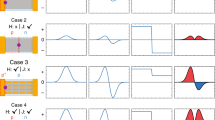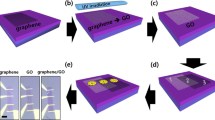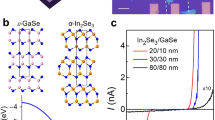Abstract
Electronic coupling of graphene atop a bulk semiconductor and the resultant interfacial energy-band reorganization create a light-sensitive junction only one atom below the front surface. Uniquely, this architecture leads to the surface being in extremely close proximity to the depletion region (typically buried several micrometres under the surface for a conventional wafer-based p–n junction solar cell), thus providing direct access to the photosensitive junction, which can be modified by surface functionalization and/or incorporation of plasmonic nanoparticles. The surface-based heterojunction, tunable carrier transport and relatively enhanced optical absorption in such 2D-layer-interfaced 3D semiconductor systems will have a transformative impact in the field of 2D optoelectronics, photovoltaics, photonics and nanoelectronics.
This is a preview of subscription content, access via your institution
Access options
Access Nature and 54 other Nature Portfolio journals
Get Nature+, our best-value online-access subscription
$29.99 / 30 days
cancel any time
Subscribe to this journal
Receive 12 print issues and online access
$209.00 per year
only $17.42 per issue
Buy this article
- Purchase on Springer Link
- Instant access to full article PDF
Prices may be subject to local taxes which are calculated during checkout




Similar content being viewed by others
References
Won, R. Photovoltaics: graphene–silicon solar cells. Nat Photon. 4, 411 (2010).
Bonaccorso, F., Sun, Z., Hasan, T. & Ferrari, A. C. Graphene photonics and optoelectronics. Nat. Photon. 4, 611–622 (2010).
Vaianella, F., Rosolen, G. & Maes, B. Graphene as a transparent electrode for amorphous silicon-based solar cells. J. Appl. Phys. 117, 243102 (2015).
Lee, T. et al. InGaN-based p–i–n solar cells with graphene electrodes. Appl. Phys. Express 4, 052302 (2011).
Behura, S. K., Nayak, S., Mukhopadhyay, I. & Jani, O. Junction characteristics of chemically-derived graphene/p-Si heterojunction solar cell. Carbon 67, 766–774 (2014).
Kavan, L., Yum, J. H. & Grätzel, M. Optically transparent cathode for dye-sensitized solar cells based on graphene nanoplatelets. ACS Nano 5, 165–172 (2011).
Wang, Y., Chen, X., Zhong, Y., Zhu, F. & Loh, K. P. Large area, continuous, few-layered graphene as anodes in organic photovoltaic devices. Appl. Phys. Lett. 95, 063302 (2009).
Yang, Q.-D. et al. Graphene oxide as an efficient hole-transporting material for high-performance perovskite solar cells with enhanced stability. J. Mater. Chem. A 5, 9852–9858 (2017).
Li, X., Lv, Z. L. & Zhu, H. Carbon/silicon heterojunction solar cells: state of the art and prospects. Adv. Mater. 27, 6549–6574 (2015).
Sze, S. M. Physics of Semiconductor Devices 2nd edn (Wiley, 1981). .
Park, H. K. & Choi, J. Origin of voltage-dependent high ideality factors in graphene–silicon diodes. Adv. Electron. Mater. 4, 1700317 (2018).
Ryu, S. et al. Atmospheric oxygen binding and hole doping in deformed graphene on a SiO2 substrate. Nano Lett. 10, 4944–4951 (2010).
Xu, D., Yu, X., Yang, L. & Yang, D. Interface engineering of graphene–silicon heterojunction solar cells. Superlattices Microstruct. 99, 3–12 (2016).
Li, X. & Zhu, H. The graphene–semiconductor Schottky junction. Phys. Today 69, 46–51 (2016).
Bhopal, M. F., Lee, D. W., ur Rehman, A. & Lee, S. H. Past and future of graphene/silicon heterojunction solar cells: a review. J. Mater. Chem. C 5, 10701–10714 (2017).
Bae, S. et al. Roll-to-roll production of 30-inch graphene films for transparent electrodes. Nat. Nanotechnol. 5, 574–578 (2010).
Li, X. et al. Graphene-on-silicon Schottky junction solar cells. Adv. Mater. 22, 2743–2748 (2010).
Li, X. et al. Ion doping of graphene for high-efficiency heterojunction solar cells. Nanoscale 5, 1945–1948 (2013).
Cui, T. X. et al. Enhanced efficiency of graphene/silicon heterojunction solar cells by molecular doping. J. Mater. Chem. A 1, 5736–5740 (2013).
Liu, X. et al. Enhanced efficiency of graphene–silicon Schottky junction solar cells by doping with Au nanoparticles. Appl. Phys. Lett. 105, 183901 (2014).
Che, S. et al. Retained carrier-mobility and enhanced plasmonic-photovoltaics of graphene via ring-centered η6 functionalization and nanointerfacing. Nano Lett. 17, 4381–4389 (2017).
Shi, E. et al. Colloidal antireflection coating improves graphene–silicon solar cells. Nano Lett. 13, 1776–1781 (2013).
Yang, L. et al. An 8.68% efficiency chemically-doped-free graphene-silicon solar cell using silver nanowires network buried contacts. ACS Appl. Mater. Interfaces 7, 4135–4141 (2015).
Yavuz, S. et al. Graphene oxide as a p-dopant and an anti-reflection coating layer, in graphene/silicon solar cells. Nanoscale 8, 6473–6478 (2016).
Meng, J. H. et al. Interface engineering for highly efficient graphene-on-silicon Schottky junction solar cells by introducing a hexagonal boron nitride interlayer. Nano Energy 28, 44–50 (2016).
Dikai, X. et al. Illumination-induced hole doping for performance improvement of graphene/n-silicon solar cells with P3HT interlayer. Adv. Electron. Mater. 3, 1600516 (2017).
Song, Y. et al. Role of interfacial oxide in high-efficiency graphene-silicon Schottky barrier solar cells. Nano Lett. 15, 2104–2110 (2015).
Jiao, K. et al. The role of MoS2 as an interfacial layer in graphene/silicon solar cells. Phys. Chem. Chem. Phys. 17, 8182–8186 (2015).
Tsuboi, Y. et al. Enhanced photovoltaic performances of graphene/Si solar cells by insertion of a MoS2 thin film. Nanoscale 7, 14476–14482 (2015).
Li, X. et al. 18.5% efficient graphene/GaAs van der Waals heterostructure solar cell. Nano Energy 16, 310–319 (2015).
He, H. et al. 13.7% efficiency graphene-gallium arsenide Schottky junction solar cells with a P3HT hole transport layer. Nano Energy 16, 91–98 (2015).
Kalita, G., Dzulsyahmi Shaarin, M., Paudel, B., Mahyavanshi, R. & Tanemura, M. Temperature dependent diode and photovoltaic characteristics of graphene–GaN heterojunction. Appl. Phys. Lett. 111, 013504 (2017).
Wang, P. et al. Tunable graphene/indium phosphide heterostructure solar cells. Nano Energy 13, 509–517 (2015).
Yang, W. S. et al. Iodide management in formamidinium-lead-halide-based perovskite layers for efficient solar cells. Science 356, 1376–1379 (2017).
Rong, Y., Liu, L., Mei, A., Li, X. & HanH.. mesoscopic perovskite solar cells. Beyond efficiency: the challenge of stability in Adv. Energy Mater 5, 1501066 (2015).
Grancini, G. et al. One-year stable perovskite solar cells by 2D/3D interface engineering. Nat. Commun. 8, 15684 (2017).
Acknowledgements
S.K.B. and V.B. thank Dimerond Technologies, LLC for the support to conduct renewable energy research at the University of Illinois at Chicago. All the authors thank the University of Illinois at Chicago for the support. V.B. thanks funding support from the National Science Foundation (grant: 1054877) and the Office of Naval Research (grants: N000141110767 and N000141812583).
Author information
Authors and Affiliations
Corresponding authors
Ethics declarations
Competing interests
The authors declare no competing interests.
Additional information
Publisher’s note: Springer Nature remains neutral with regard to jurisdictional claims in published maps and institutional affiliations.
Rights and permissions
About this article
Cite this article
Behura, S.K., Wang, C., Wen, Y. et al. Graphene–semiconductor heterojunction sheds light on emerging photovoltaics. Nat. Photonics 13, 312–318 (2019). https://doi.org/10.1038/s41566-019-0391-9
Received:
Accepted:
Published:
Issue Date:
DOI: https://doi.org/10.1038/s41566-019-0391-9
This article is cited by
-
Miniaturized spectrometer with intrinsic long-term image memory
Nature Communications (2024)
-
Stepwise reduction of graphene oxide and studies on defect-controlled physical properties
Scientific Reports (2024)
-
On-chip optoelectronic logic gates operating in the telecom band
Nature Photonics (2024)
-
Graphene oxide for photonics, electronics and optoelectronics
Nature Reviews Chemistry (2023)
-
Designable heteronanocrystals via interface redox reaction
Nano Research (2023)



